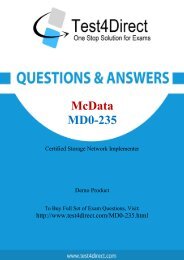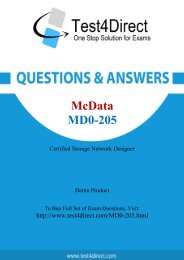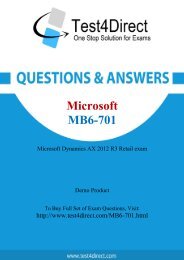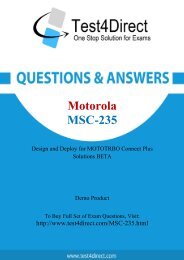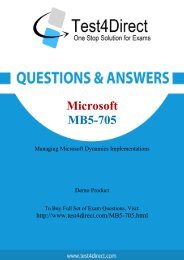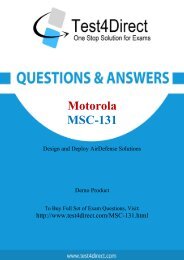ISSMP-demo
You also want an ePaper? Increase the reach of your titles
YUMPU automatically turns print PDFs into web optimized ePapers that Google loves.
Opinions: The following are the two types of opinions:<br />
1. Expert: It offers an opinion based on personal expertise and facts.<br />
2. Non expert: It can testify only to facts.Circumstantial evidence:It is the inference of information<br />
from other, intermediate, relevant facts.<br />
Hearsay evidence: This evidence is commonly not admissible in court. It is a third-party evidence.<br />
Computer-generated records and other business records fall under the category of hearsay evidence<br />
because these records cannot be proven accurate and reliable.<br />
Reference: CISM Review Manual 2010, Contents: "Incident Management and Response"<br />
Question: 7<br />
Which of the following penetration testing phases involves reconnaissance or data gathering?<br />
A. Attack phase<br />
B. Pre-attack phase<br />
C. Post-attack phase<br />
D. Out-attack phase<br />
Question: 8<br />
Answer: B<br />
Explanation:<br />
The pre-attack phase is the first step for a penetration tester. The pre-attack phase involves<br />
reconnaissance or data gathering. It also includes gathering data from Whois, DNS, and network<br />
scanning, which help in mapping a target network and provide valuable information regarding the<br />
operating system and applications running on the systems. Penetration testing involves locating the<br />
IP block and using domain name Whois to find personnel contact information.<br />
Answer option A is incorrect. The attack phase is the most important phase of penetration testing.<br />
Different exploitive and responsive hacking tools are used to monitor and test the security of systems<br />
and the network. Some of the actions performed in the attack phase are as follows:<br />
Penetrating the perimeter<br />
Escalating privileges<br />
Executing, implanting, and retracting<br />
Answer option C is incorrect. The post-attack phase involves restoring the system to normal pre-test<br />
configurations. It includes removing files, cleaning registry entries, and removing shares and<br />
connections. Analyzing all the results and presenting them in a comprehensive report is also the part<br />
of this phase. These reports include objectives, observations, all activities undertaken, and the<br />
results of test activities, and may recommend fixes for vulnerabilities.<br />
Mark works as a security manager for SoftTech Inc. He is involved in the BIA phase to create a<br />
document to be used to help understand what impact a disruptive event would have on the<br />
business. The impact might be financial or operational. Which of the following are the objectives<br />
related to the above phase in which Mark is involved?<br />
Each correct answer represents a part of the solution. Choose three.<br />
A. Resource requirements identification<br />
B. Criticality prioritization<br />
C. Down-time estimation






